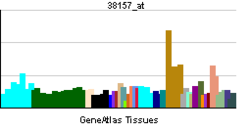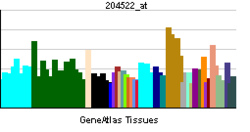- DOM3Z
-
Dom-3 homolog Z (C. elegans) Identifiers Symbols DOM3Z; DOM3L; NG6; RAI1 External IDs OMIM: 605996 MGI: 1890444 HomoloGene: 38061 GeneCards: DOM3Z Gene Gene Ontology Molecular function • nucleotide binding
• protein binding
• identical protein binding
• metal ion bindingSources: Amigo / QuickGO RNA expression pattern 


More reference expression data Orthologs Species Human Mouse Entrez 1797 112403 Ensembl ENSG00000204348 ENSMUSG00000040482 UniProt O77932 O70348 RefSeq (mRNA) NM_005510 NM_033613 RefSeq (protein) NP_005501 NP_291091 Location (UCSC) Chr 6:
32.05 – 32.05 MbChr 17:
34.97 – 34.98 MbPubMed search [1] [2] Protein Dom3Z is a protein that in humans is encoded by the DOM3Z gene.[1][2]
This gene localizes to the major histocompatibility complex (MHC) class III region on chromosome 6. The function of its protein product is unknown, but its ubiquitous expression and conservation in both simple and complex eukaryotes suggests that this may be a housekeeping gene.[2]
References
- ^ Yang Z, Shen L, Dangel AW, Wu LC, Yu CY (Dec 1998). "Four ubiquitously expressed genes, RD (D6S45)-SKI2W (SKIV2L)-DOM3Z-RP1 (D6S60E), are present between complement component genes factor B and C4 in the class III region of the HLA". Genomics 53 (3): 338–47. doi:10.1006/geno.1998.5499. PMID 9799600.
- ^ a b "Entrez Gene: DOM3Z dom-3 homolog Z (C. elegans)". http://www.ncbi.nlm.nih.gov/sites/entrez?Db=gene&Cmd=ShowDetailView&TermToSearch=1797.
Further reading
- Yu CY (1999). "Molecular genetics of the human MHC complement gene cluster.". Exp. Clin. Immunogenet. 15 (4): 213–30. doi:10.1159/000019075. PMID 10072631.
- Yang Z, Yu CY (2000). "Organizations and gene duplications of the human and mouse MHC complement gene clusters.". Exp. Clin. Immunogenet. 17 (1): 1–17. doi:10.1159/000019119. PMID 10686478.
- Strausberg RL, Feingold EA, Grouse LH, et al. (2003). "Generation and initial analysis of more than 15,000 full-length human and mouse cDNA sequences.". Proc. Natl. Acad. Sci. U.S.A. 99 (26): 16899–903. doi:10.1073/pnas.242603899. PMC 139241. PMID 12477932. http://www.pubmedcentral.nih.gov/articlerender.fcgi?tool=pmcentrez&artid=139241.
- Mungall AJ, Palmer SA, Sims SK, et al. (2003). "The DNA sequence and analysis of human chromosome 6.". Nature 425 (6960): 805–11. doi:10.1038/nature02055. PMID 14574404.
- Xie T, Rowen L, Aguado B, et al. (2004). "Analysis of the gene-dense major histocompatibility complex class III region and its comparison to mouse.". Genome Res. 13 (12): 2621–36. doi:10.1101/gr.1736803. PMC 403804. PMID 14656967. http://www.pubmedcentral.nih.gov/articlerender.fcgi?tool=pmcentrez&artid=403804.
- Lehner B, Semple JI, Brown SE, et al. (2004). "Analysis of a high-throughput yeast two-hybrid system and its use to predict the function of intracellular proteins encoded within the human MHC class III region.". Genomics 83 (1): 153–67. doi:10.1016/S0888-7543(03)00235-0. PMID 14667819.
- Lehner B, Sanderson CM (2004). "A protein interaction framework for human mRNA degradation.". Genome Res. 14 (7): 1315–23. doi:10.1101/gr.2122004. PMC 442147. PMID 15231747. http://www.pubmedcentral.nih.gov/articlerender.fcgi?tool=pmcentrez&artid=442147.
- Gerhard DS, Wagner L, Feingold EA, et al. (2004). "The status, quality, and expansion of the NIH full-length cDNA project: the Mammalian Gene Collection (MGC).". Genome Res. 14 (10B): 2121–7. doi:10.1101/gr.2596504. PMC 528928. PMID 15489334. http://www.pubmedcentral.nih.gov/articlerender.fcgi?tool=pmcentrez&artid=528928.
- Rual JF, Venkatesan K, Hao T, et al. (2005). "Towards a proteome-scale map of the human protein-protein interaction network.". Nature 437 (7062): 1173–8. doi:10.1038/nature04209. PMID 16189514.
Categories:- Human proteins
- Chromosome 6 gene stubs
Wikimedia Foundation. 2010.
